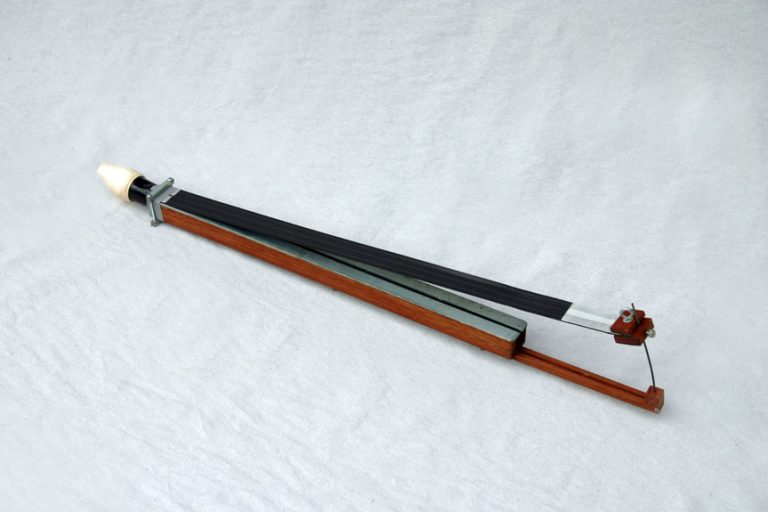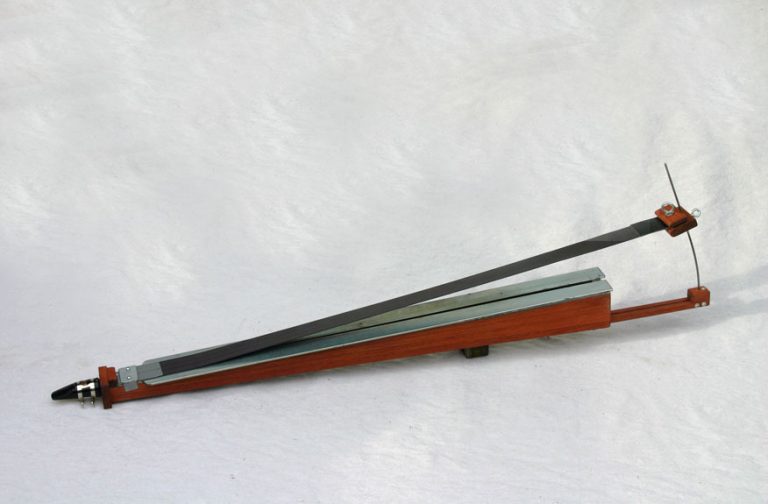When musicians and builders explore new sounds, they often arrive at surprising inventions.
This is the story of the Moe family of instruments, created by Bart Hopkin in the 1990s, and the Glissotar, developed two decades later — separate creations, but connected by a shared curiosity for continuous-pitch wind instruments.
Bart Hopkin and the Moe Instruments
Bart Hopkin is a legendary figure in the world of experimental musical instruments. Since the 1970s, he has composed, performed, built instruments, and published countless resources on inventive acoustic design.
In the early 1990s, he introduced the Moe family: wind instruments using a magnetic strip pitch control system.
A steel plate on the body of the instrument is attracted to a strip of magnetic foil, sealing the slot airtight while allowing continuous pitch slides.
- The Moe flute, with a recorder-style mouthpiece, has a bright and airy tone, responsive to subtle breath and finger changes.
- The original Moe clarinet-like instrument produced a warm, woody voice, with glissando control reminiscent of the human voice.
- Other variations included the Moe Sax, with its brassier tenor saxophone sound, and the Moe Mem, replacing a reed with a vibrating membrane.
The Moe family stands as a fascinating chapter in the long history of slide woodwinds, alongside rarities like the King C Saxoprano from the 1920s.
Source: https://barthopkin.com/instrumentarium/
The Glissotar: A Different Invention
Decades later, in the 2010s, the Glissotar was developed.
It uses two precisely matched magnetic strips, one on the body and one stretched above, to achieve smooth, continuous pitch.
It’s important to note: the Glissotar was not a continuation of the Moe instruments, and it was not directly inspired by them.
It came from an independent line of exploration, rooted in a desire to make a modern, production-quality slide woodwind.
Yet, when we discovered Bart Hopkin’s Moe instruments, we immediately felt a connection. We reached out to Bart, and since then we’ve had a friendly relationship. Sharing ideas and respecting each other’s work has been part of that exchange.
Parallel Explorations
Both the Moe instruments and the Glissotar show that musicians and makers across different times and places often arrive at similar questions:
- How can a wind instrument move continuously between notes, instead of fixed steps?
- What new sounds appear when we change the traditional mouthpiece or reed?
- How can acoustics, mechanics, and creativity combine to create something truly new?
The Moe family and the Glissotar answer these questions in different ways — but both highlight the joy of exploration.
Continuing the Dialogue
At Glissonic, we believe that these stories are not about “who was first” but about a community of inventors and musicians keeping alive the spirit of experimentation.
That’s why we are glad to feature Bart Hopkin’s work in our film and blog. His creativity has inspired many builders, and the Moe instruments remain an important part of experimental instrument history.
The Glissotar continues this journey in its own way, bringing continuous-pitch woodwinds into a modern production context.
Want to see more?
- The full video documentary about Moe instruments and the Glissotar is available on our YouTube channel.
- We also recommend exploring Bart Hopkin’s website for more of his brilliant inventions.
- And of course, check out our Glissonic blog archive for deeper dives into the history of slide woodwinds.
Different inventions.
Independent paths.
A shared love of sound.
That’s what connects the Moe instruments and the Glissotar.






